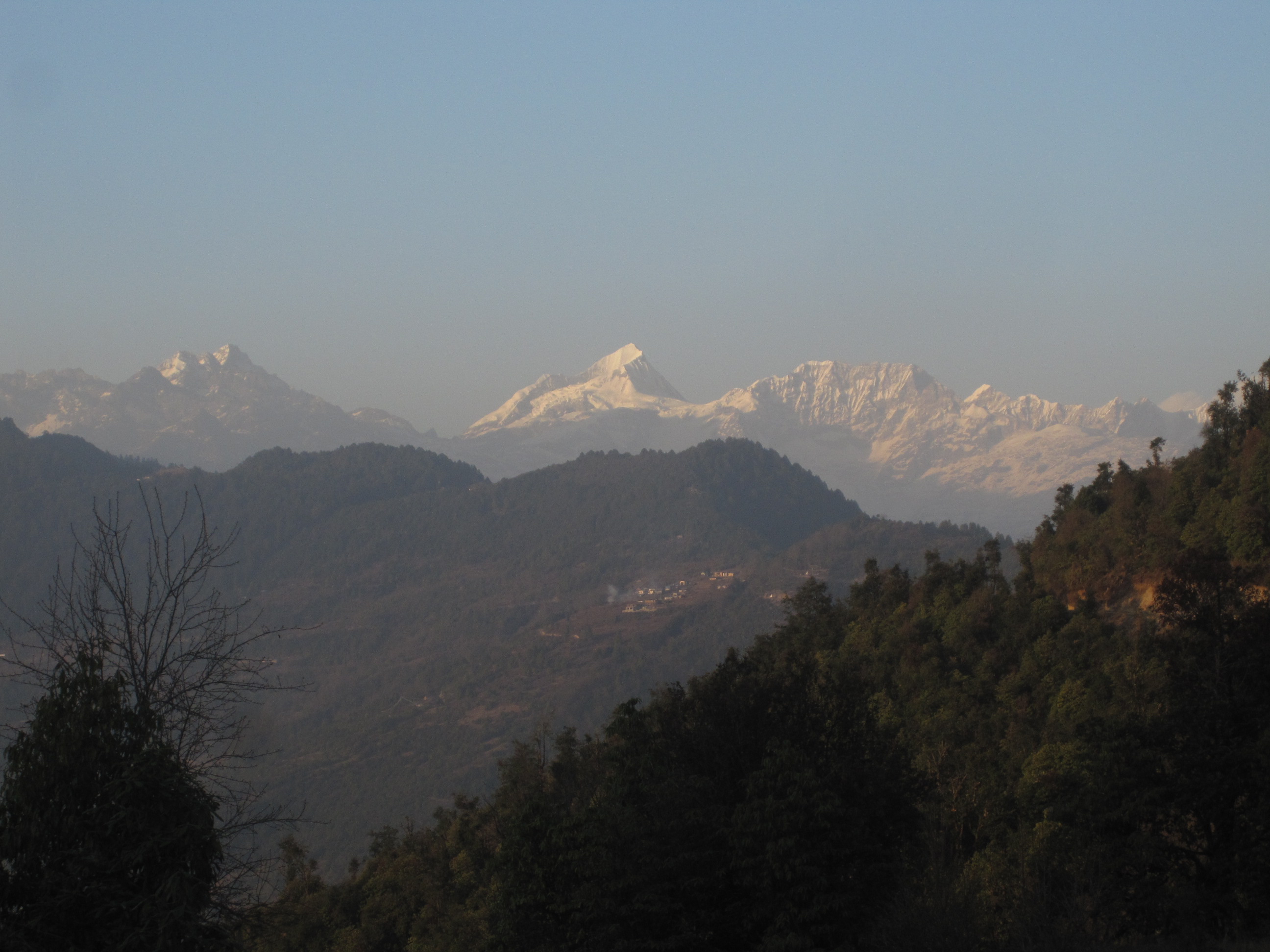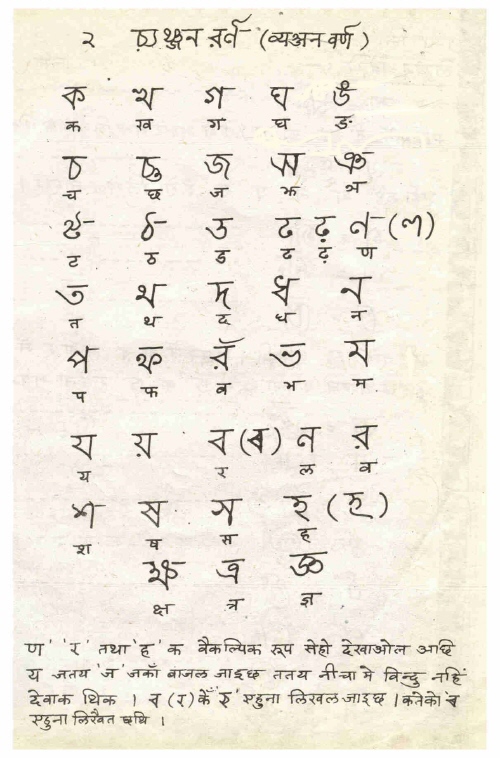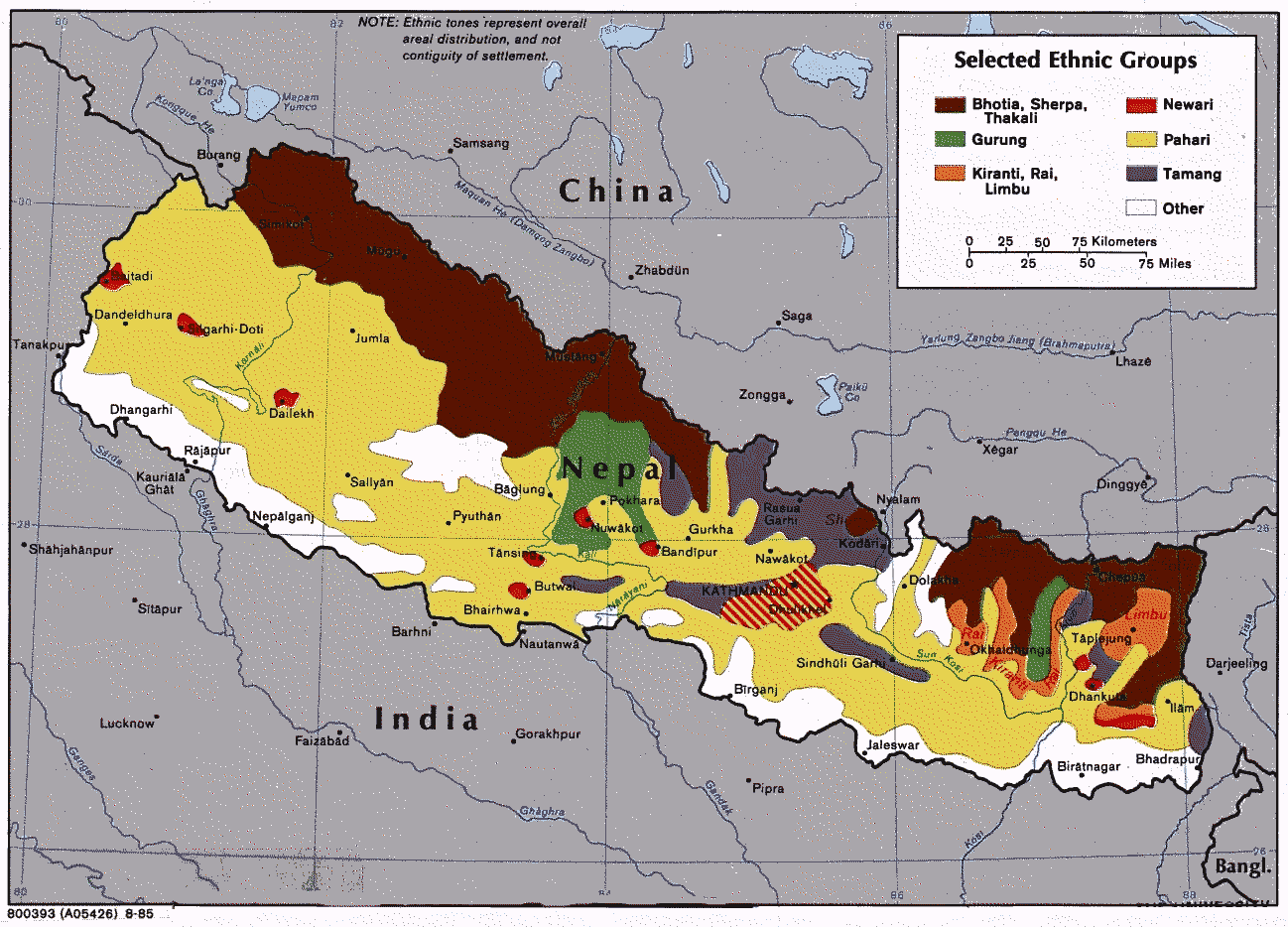|
Sunapati Rural Municipality
Sunapati is a Rural municipality located within the Ramechhap District of the Bagmati Province of Nepal. The municipality spans of area, with a total population of 18,141 according to a 2011 Nepal census. On March 10, 2017, the Government of Nepal restructured the local level bodies into 753 new local level structures. The previous Dimipokhari, Hiledevi, Bethan, Khaniyapani and small portion of Gunsi Bhadaure VDCs were merged to form Sunapati Rural Municipality. Sunapati is divided into 5 wards, with Hiledevi declared the administrative center of the rural municipality. Demographics At the time of the 2011 Nepal census, Sunapati Rural Municipality had a population of 18,148. Of these, 52.6% spoke Nepali, 34.6% Tamang, 11.2% Newar, 0.6% Majhi, 0.4% Magar, 0.3% Doteli, 0.1% Maithili, 0.1% Yolmo and 0.2% other languages as their first language. In terms of ethnicity/caste, 34.9% were Tamang, 20.1% Chhetri, 17.3% Newar, 9.4% Hill Brahmin, 9.2% Magar, 2.5% Kami, 2. ... [...More Info...] [...Related Items...] OR: [Wikipedia] [Google] [Baidu] |
Gaunpalika
A gaunpalika ( ne, गाउँपालिका, lit=rural municipality, translit=Gāum̐pālikā ) is an administrative division in Nepal. The Ministry of Federal Affairs and Local Development dissolved the existing village development committees and announced the establishment of this new local body. It is a sub-unit of a district. There are currently 460 rural municipalities. History The village development committee was the previous governing body of villages in Nepal. They were replaced on 10 May 2017 by the rural municipalities which were formed by combining different VDCs. The decision was taken by the cabinet of Nepal after modifications in the report proposed by the Local Level Restructuring Commission. Initially 481 rural municipalities were formed but it was later changed to 460 municipalities. According to the Ministry of Federal Affairs and Local Development the new bodies were to be called "rural municipality" and not "village council" which was the literal tran ... [...More Info...] [...Related Items...] OR: [Wikipedia] [Google] [Baidu] |
Gunsi Bhadaure
Gunsi Bhadaure is a village development committee in Ramechhap District in the Janakpur Zone of north-eastern Nepal. At the time of the 1991 Nepal census The 1991 Nepal census was a widespread national census conducted by the Nepal Central Bureau of Statistics. Working with Nepal's Village Development Committees at a district level, they recorded data from all the main towns and villages of each ... it had a population of 4,945 people living in 895 individual households.. References External linksUN map of the municipalities of Ramechhap District Populated places in Ramechhap District {{Ramechhap-geo-stub ... [...More Info...] [...Related Items...] OR: [Wikipedia] [Google] [Baidu] |
Newar People
Newar (; new, नेवार, endonym: Newa; new, नेवा, Pracalit script:) or Nepami, are the historical inhabitants of the Kathmandu Valley and its surrounding areas in Nepal and the creators of its historic heritage and civilisation. Page 15. Newars form a linguistic and cultural community of primarily Indo-Aryan and Tibeto-Burman ethnicities following Hinduism and Buddhism with Nepal Bhasa as their common language. Newars have developed a division of labour and a sophisticated urban civilisation not seen elsewhere in the Himalayan foothills. Newars have continued their age-old traditions and practices and pride themselves as the true custodians of the religion, culture and civilisation of Nepal. Newars are known for their contributions to culture, art and literature, trade, agriculture and cuisine. Today, they consistently rank as the most economically and socially advanced community of Nepal, according to the annual Human Development Index published by UNDP. Nepal ... [...More Info...] [...Related Items...] OR: [Wikipedia] [Google] [Baidu] |
Chhetri
Chhetri (Kshetri, Kshettri, Kshetry or Chhettri), ( ne, क्षेत्री ; IAST: ''Kṣetrī'') historically called Kshettriya or Kshetriya or Khas are Nepali speakers of Khas community, some of whom trace their origin to migration from medieval India. Chhetri was a caste of administrators, governor and military elites in the medieval Khas Kingdom and Gorkha Kingdom (later unified Kingdom of Nepal). The nobility of the Gorkha Kingdom mainly originated from Chhetri families. They also had a strong presence in civil administration affairs. The bulk of prime ministers of Nepal before the democratization of Nepal belonged to this caste as a result of the old Gorkhali aristocracy. Gorkha-based aristocratic Chhetri families included the Pande dynasty, the Basnyat dynasty, the Kunwar family, and the Thapa dynasty, (Rana dynasty and other Kunwars). Khas Chhetris were traditionally considered a division of the Khas people with Khas Brahmin (commonly called Khas Bahun). They m ... [...More Info...] [...Related Items...] OR: [Wikipedia] [Google] [Baidu] |
Tamang People
The Tamang (; Devanagari: तामाङ; ''tāmāṅ'') are an Tibeto-Burmese ethnic group of Nepal. In Nepal Tamang/Moormi people constitute 5.6% of the Nepalese population at over 1.3 million in 2001, increasing to 1,539,830 as of the 2011 census. Tamang people are also found in significant numbers in the Indian state of Sikkim and districts of Darjeeling and Kalimpong in West Bengal state of India and various districts in the southern foothills of the Kingdom of Bhutan. Such districts include the Tsirang District, the Dagana District, the Samtse District, the Chukha District, the Sarpang District and the Samdrup Jongkhar District. Emergent North-East : A Way Forward By H. C. Sadangi Tamang language is the fifth most-spoken language in Nepal. Etymology ''Tamang'' may be derived from the word ''Tamang'', where ''Ta'' means "horse" and ''Mak'' means "warrior" in Tibetan. However, there are no written documentations of Horse Riders. Some scientific research claims Tamangs ha ... [...More Info...] [...Related Items...] OR: [Wikipedia] [Google] [Baidu] |
Yolmo Language
Yolmo (Hyolmo) or Helambu Sherpa, is a Tibeto-Burman language of the Hyolmo people of Nepal (ISO 639-3: scp, GlottoCodeyolm1234. Yolmo is spoken predominantly in the Helambu and Melamchi valleys in northern Nuwakot District and northwestern Sindhupalchowk District. Dialects are also spoken by smaller populations in Lamjung District and Ilam District and also in Ramecchap District (where it is known as Syuba). It is very similar to Kyirong Tibetan and less similar to Standard Tibetan and Sherpa. There are approximately 10,000 Yolmo speakers, although some dialects have larger populations than others. Language name Yolmo is both the name of the language (glottonym), and the ethnic group of people who speak the language (ethnonym). Yolmo is also written ''Hyolmo, Yholmo'' or ''Yohlmo''. The 'h' in all of these spellings marks that the word has low tone. Sometimes the language is referred to as ''Yolmo Tam'', ''tam'' is the Yolmo word for 'language'. The language is also refe ... [...More Info...] [...Related Items...] OR: [Wikipedia] [Google] [Baidu] |
Maithili Language
Maithili () is an Indo-Aryan language spoken in parts of Languages of India, India and Languages of Nepal, Nepal. It is native to the Mithila region, which encompasses parts of the Indian states of Bihar and Jharkhand as well as Nepal's eastern Terai. It is one of the 22 Eighth Schedule to the Constitution of India, officially recognised languages of India and the second most spoken Languages of Nepal, Nepalese language in Nepal. The language is predominantly written in Devanagari, but there were two other historically important scripts: Tirhuta script, Tirhuta, which has retained some use until the present, and Kaithi script, Kaithi. Official status In 2003, Maithili was included in the 8th Schedule, Eighth Schedule of the Indian Constitution as a recognised language of India, Indian language, which allows it to be used in education, government, and other official contexts in India. Maithili language is included as an optional paper in the Union Public Service Commission, UP ... [...More Info...] [...Related Items...] OR: [Wikipedia] [Google] [Baidu] |
Doteli
Doteli, or Dotyali () is an Indo-Aryan language spoken by about 800,000 people, most of whom live in Nepal. It is a dialect of Khas, which is an ancient form of the modern Nepali language, and is written in the Devanagari script. It has official status in Nepal as per Part 1, Section 6 of the Constitution of Nepal 2072 (2015). There are four main dialects of Doteli, namely Baitadeli, Bajhangi Nepali, Darchuli and Doteli. The mutual intelligibility between these dialects is high and all dialects of Doteli are able to share language-based materials. Names of the language The language is known by various names in the far–western region of Nepal, according to the districts. Official status The Language Commission of Nepal has recommended Dotyali language as official language in Sudurpashchim Province. Origin and history According to Rahul Sankrityayan Doteli or Dotyali is a dialect of the Kumaoni language which was brought to Doti by a section of the Katyuri dynasty of Kum ... [...More Info...] [...Related Items...] OR: [Wikipedia] [Google] [Baidu] |
Magar Language
Magar Dhut ( ne, मगर ढुट, ) is a Sino-Tibetan Language spoken mainly in Nepal, Southern Bhutan, and in Darjeeling and Sikkim, India, by the Magar people. It is divided into two groups (Eastern and Western) and further dialect divisions give distinct tribal identity. In Nepal 788,530 people speak the language. While the government of Nepal developed Magar language curricula, as provisioned by the constitution, the teaching materials have never successfully reached Magar schools, where most school instruction is in the Nepali language. It is not unusual for groups with their own language to feel that the "mother-tongue" is an essential part of identity. The Dhut Magar language is sometimes lumped with the Magar Kham language spoken further west in Bheri, Dhaulagiri, and Rapti zones. Although the two languages share many common words, they have major structural differences and are not mutually intelligible. Geographical distribution Western Magar Western Magar ... [...More Info...] [...Related Items...] OR: [Wikipedia] [Google] [Baidu] |
Majhi Language
Majhi is an Indo-Aryan language spoken in parts of Nepal and formerly in some small pockets of neighboring India.:1 The language is associated with the Majhi people, an ethnic group in those regions who dwell historically near the Saptakoshi River and its tributaries and elsewhere in central and eastern Nepal. The Majhi people generally subsist off of work associated with rivers, including fishing and ferrying.:2 Majhi is written using the Devanagari writing system. Ethnologue classifies Mahji as a 6b threatened language. There are roughly 24,400 L1 speakers of Majhi in Nepal and roughly 46,120 L1 and L2 speakers of the language around the globe. Most of the Majhi speakers in Nepal are bilingual with the more predominant Nepali language,:2 and the latter language is replacing Majhi in use. Majhi's lack of official status, use in education, in media, in print, etc. places the survival of the language in a precarious position.:2 The last speaker in India, Thak Bahadur Majhi of Jor ... [...More Info...] [...Related Items...] OR: [Wikipedia] [Google] [Baidu] |
Newar Language
Newar (), or Newari and known officially in Nepal as Nepal Bhasa, is a Sino-Tibetan language spoken by the Newar people, the indigenous inhabitants of Nepal Mandala, which consists of the Kathmandu Valley and surrounding regions in Nepal. "Nepal Bhasa" literally means "Nepalese language", however the language is not the same as Nepali (Devanāgarī: नेपाली), the country's current official language of the central government. The two languages belong to different language families (Sino-Tibetan and Indo-European, respectively), but centuries of contact have resulted in a significant body of shared vocabulary. Newar was Nepal's administrative language from the 14th to the late 18th century. From the early 20th century until democratisation, Newar suffered from official suppression. From 1952 to 1991, the percentage of Newar speakers in the Kathmandu Valley dropped from 75% to 44% and today Newar culture and language are under threat. The language has been listed ... [...More Info...] [...Related Items...] OR: [Wikipedia] [Google] [Baidu] |
Tamang Language
Tamang (Devanagari: तामाङ; ''tāmāng'') is a term used to collectively refer to a dialect cluster spoken mainly in Nepal, Sikkim, West Bengal (Darjeeling) and North-Eastern India. It comprises Eastern Tamang, Northwestern Tamang, Southwestern Tamang, Eastern Gorkha Tamang, and Western Tamang. Lexical similarity between Eastern Tamang (which is regarded as the most prominent) and other Tamang languages varies between 81% to 63%. For comparison, lexical similarity between Spanish and Portuguese, is estimated at 89%. Ethnologue report for Spanish Dialects ''Ethnologue'' divides Tamang into the following varieties due to mutual unintelligibility. *Eastern Tamang: 759,000 in Nepal (2000 WCD). Population total all countries: 773,000. Sub-dialects are as follows. **Outer-Eastern Tamang (Sailung Tamang) **Central-Eastern Tamang (Temal Tamang) **Southwestern Tamang (Kath-Bhotiya, Lama Bhote, Murmi, Rongba, Sain, Tamang Gyoi, Tamang Gyot, Tamang Lengmo, Tamang Tam) *Western T ... [...More Info...] [...Related Items...] OR: [Wikipedia] [Google] [Baidu] |






